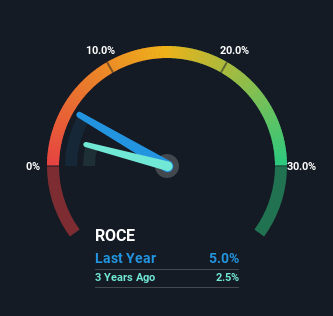- United States
- /
- Other Utilities
- /
- NYSE:NI
NiSource (NYSE:NI) Has More To Do To Multiply In Value Going Forward
If you're looking for a multi-bagger, there's a few things to keep an eye out for. Firstly, we'd want to identify a growing return on capital employed (ROCE) and then alongside that, an ever-increasing base of capital employed. Put simply, these types of businesses are compounding machines, meaning they are continually reinvesting their earnings at ever-higher rates of return. Although, when we looked at NiSource (NYSE:NI), it didn't seem to tick all of these boxes.
What Is Return On Capital Employed (ROCE)?
For those that aren't sure what ROCE is, it measures the amount of pre-tax profits a company can generate from the capital employed in its business. The formula for this calculation on NiSource is:
Return on Capital Employed = Earnings Before Interest and Tax (EBIT) ÷ (Total Assets - Current Liabilities)
0.05 = US$1.1b ÷ (US$25b - US$3.0b) (Based on the trailing twelve months to June 2022).
So, NiSource has an ROCE of 5.0%. Even though it's in line with the industry average of 4.7%, it's still a low return by itself.
View our latest analysis for NiSource

In the above chart we have measured NiSource's prior ROCE against its prior performance, but the future is arguably more important. If you're interested, you can view the analysts predictions in our free report on analyst forecasts for the company.
So How Is NiSource's ROCE Trending?
There are better returns on capital out there than what we're seeing at NiSource. The company has employed 36% more capital in the last five years, and the returns on that capital have remained stable at 5.0%. Given the company has increased the amount of capital employed, it appears the investments that have been made simply don't provide a high return on capital.
What We Can Learn From NiSource's ROCE
As we've seen above, NiSource's returns on capital haven't increased but it is reinvesting in the business. Unsurprisingly, the stock has only gained 32% over the last five years, which potentially indicates that investors are accounting for this going forward. As a result, if you're hunting for a multi-bagger, we think you'd have more luck elsewhere.
One more thing: We've identified 3 warning signs with NiSource (at least 1 which is significant) , and understanding them would certainly be useful.
For those who like to invest in solid companies, check out this free list of companies with solid balance sheets and high returns on equity.
Valuation is complex, but we're here to simplify it.
Discover if NiSource might be undervalued or overvalued with our detailed analysis, featuring fair value estimates, potential risks, dividends, insider trades, and its financial condition.
Access Free AnalysisHave feedback on this article? Concerned about the content? Get in touch with us directly. Alternatively, email editorial-team (at) simplywallst.com.
This article by Simply Wall St is general in nature. We provide commentary based on historical data and analyst forecasts only using an unbiased methodology and our articles are not intended to be financial advice. It does not constitute a recommendation to buy or sell any stock, and does not take account of your objectives, or your financial situation. We aim to bring you long-term focused analysis driven by fundamental data. Note that our analysis may not factor in the latest price-sensitive company announcements or qualitative material. Simply Wall St has no position in any stocks mentioned.
About NYSE:NI
NiSource
An energy holding company, operates as a regulated natural gas and electric utility company in the United States.
Proven track record second-rate dividend payer.
Similar Companies
Market Insights
Community Narratives



